Death Dome 3,000
Battle on the Waspworth Plateau
In the future there is no death.
There is only Death Dome.
Battle and Upgrade!
You are the vile manager of a team of convicts forced to battle in the Death Dome. Manage your team, earn credits and upgrade your arsenal.
Death Dome is an action strategy game where you control a team of four units inside the Death Dome battleground. The objective of each match is to use your team to capture as many control points and gather as many credits as possible. To achieve this, you’ll have to fight tooth and nail against enemy teams who are prepared to do anything to win.
Between matches, you must equip your team with the best equipment that you can afford. The Death Dome arsenal consists of many savage weapons and rare pieces of armor and equipment.

Box Contents
- 1 rulebook
- 1 12-sided round counter die
- 9 7x7 board tiles
- 4 team registries: 1 of each team color
- 16 unit bases: 4 of each team color
- 80 store cards: 10 warrior, 10 gunner, 10 scout, 10 medic, 15 armor, 5 vehicle, 20 equipment
- 70 power cards
- 60 supply markers: 16 of each team color
- 2 bug tokens: 1 beehive, 1 beetle mound
- 40 credit bills: 24x 100,000cr, 12x 500,000cr, 8x 1,000,000cr
- 24 beetle shells
- 30 wound chips: 20x 1 wound chips, 10x 3 wound chips
- 27 character cards: 16 rank 0, 4 rank 1, 6 rank 2, 1 rank 3
- 27 character tokens
Table of Contents
1: Box Contents
2: Setup
3: Team Registry
4: Unit Rating
5: Item Cards
6: Game Phases, Make Purchases
7: Equipping Units
8: The Match, The Turn, Supply Points
9: Supply Point example
10: Power Cards
11: Unit Phases, Movement Phase, Action Phase
12: Combat
13: Defending, Line of Sight
14: Line of Sight Example
15: Combat Example
16-17: The Board
18-19: Special Abilities
20: Death, Jails, and Beetle Shells
21: Winning, Payouts
22-23: Death Dome Series
24-25: Card Notes
26-27: Characters
28: Optional Scenarios
29: Rules Reference
Winning the Game
A Death Dome match lasts for 6 rounds. When all players have finished the 6th and final round the match is over. Players earn credits at the end of the match for each control point in their color and each enemy unit they put in jail. The team with the largest credit payout at the end of 6 rounds is the winner.
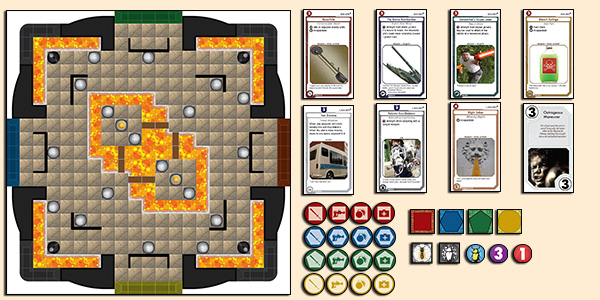
Setup
- Assemble the board as shown.
- Shuffle the power deck and place it next to the board.
- Set up each store deck to the side of the board. The store decks are the warrior, gunner, scout, medic, armor, vehicle, and equipment decks.
- Set up the credits in a bank next to the board. Set up the beetle shell, wound chips, and bug tokens next to the board.
- Each player takes a team registry card and the unit tokens and supply markers of their color. Set up your unit tokens by placing them in any space in your base.
- Each team receives 2 million credits before the start of the first match. Each player can take five 100,000 credit bills and three 500,000 credit bills from the bank.
Team Registry
Unit Types
Your team consists of four units. There are four types of units and each unit type has a specialty item deck. The unit type symbol shows what unit type each unit is and indicates which unit type deck they can equip.
Warrior
Warriors are savage brutes who have been trained in the art of hand to hand combat. Warriors utilize large, vicious weaponry to cut, maim, and bludgeon their victims from close range.
Gunner
Gunners are sturdy combat soldiers who have been trained to carry and use heavy pieces of ranged weaponry. Gunners utilize guns, cannons, and energy weapons to blast enemies from afar.
Scout
Scouts are quick, versatile soldiers who move swiftly and have been trained to use a mix of close range and long range weapons. Scouts utilize grenades, guns, and lasers to dispatch foes with cold precision.
Medic
Medics are trained physicians who can heal and enhance the performance of their fellow teammates. Medics also employ medical tools to maim their foes with utter disregard for medical propriety.
Unit Ratings
Each unit has 4 ratings:
Strength
The value added to each attack.
Movement
The maximum number of spaces a unit can move each movement phase.
Toughness
The value subtracted from an attack value before losing vitae.
Vitae
The starting and maximum life force of each unit. If a unit is reduced to zero vitae that unit dies.
Item Cards
Item Deck Type
Items from the unit decks (warrior, gunner, scout, medic) may only be used by those unit types. E.g. only medics can hold items from the medic deck.
Item Type and Range
Items can be Close Combat Weapons, Ranged Weapons, Armor, Vehicles, or Equipment. Any unit may equip armor, vehicles, or equipment. Each unit can only equip up to 1 vehicle and 1 armor at a time. A unit may equip multiple weapons but may only use 1 weapon per attack.
Ratings
If items have a rating at the top that rating is boosted on that unit. For example the Hyperbranched Aramid Blast Suit adds 2 toughness and 2 starting vitae to the unit wearing it.
Weapons add strength to attacks, but only one weapon may be used for each attack. See the special abilities section for details on all ability effects.
Abilities
Items have abilities that add special effects to the match.
Ability Name and Quote
These lines give some background on the item and have no in-game effect.
Game Phases
The game consists of 3 phases:
- Make purchases and equip team
- Play match
- Pay out winnings
Make Purchases
Before a match starts, each team may purchase items from the store. The store includes the warrior, gunner, scout, medic, armor, vehicle, and equipment decks.
Each player rolls the round counter die, the player with the highest roll is the first player. The first player takes the first purchasing turn, and purchasing continues in a clockwise order.
During each purchasing turn, a player may choose one item from a deck and pay the corresponding cost to the bank.
Each purchasing turn a player may also sell one item back to the store and receive the corresponding credits.
Equipping Units
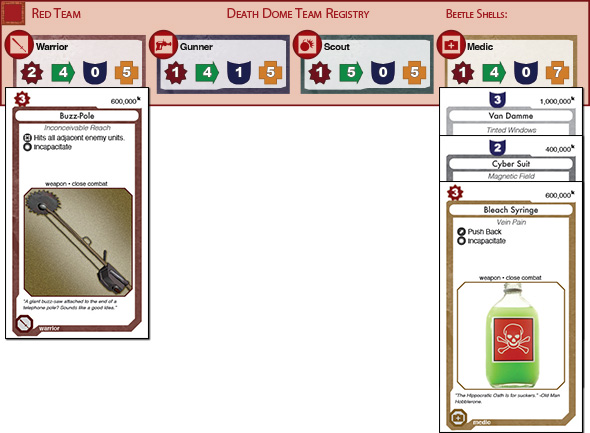
Each unit may equip up to 3 items.
It’s normal in your first game to have some units with no items. Units without items can still move, take control points, and release jails. A unit with no weapon can still make a close combat attack. (see combat)
Ending the Purchase Phase
When a player is out of credits or is done purchasing, that player may pass to the next player. A player may not pass if they have items that can’t be equipped by their team. Once all players pass, the purchasing is done and the store is closed. Stack up the store decks and set them aside.
The Match
Before the first turn, each player starts by drawing 3 power cards. Starting with the first player, each player takes a turn with play continuing in a clockwise direction. At the end of the 6th round the match is over!
The Turn
If the active player is the first player they move the round counter up by 1 (or set to 1 for the first round).
Each turn a player will:
- Draw cards according to their supply points
- Take 2 unit phases: 1 action and 1 movement for 1 unit
Draw Cards
Each player starts the game with 3 power cards. A player starts every turn by drawing power cards according to their supply points.
The player draws until their total cards in hand are equal to 3 cards plus 1 for every 5 supply points at the start of their turn.
Supply Points
- Each center tower control point is worth 5 supply points
- All other control points are worth 1 supply point
Supply Points
At the start of each turn the player draws until they have their maximum supply of cards in hand:
- 0-4 supply : 3 cards
- 5-9 supply : 4 cards
- 10-14 supply : 5 cards
- 15-19 supply : 6 cards
- 20+ supply : 7 cards
If a player already has their maximum supply or more they do not draw any cards. A player may never discard cards without playing them. The maximum hand size is 7 if a player were to draw when they have 7 cards in their hand then that player does not draw a card.
On the first turn no player will start with supply points so they will draw no additional cards and just keep the 3 they started with.
Players only draw at the beginning of their turn and only for supply points in their color, no other points count toward supply.
Supply Point Example
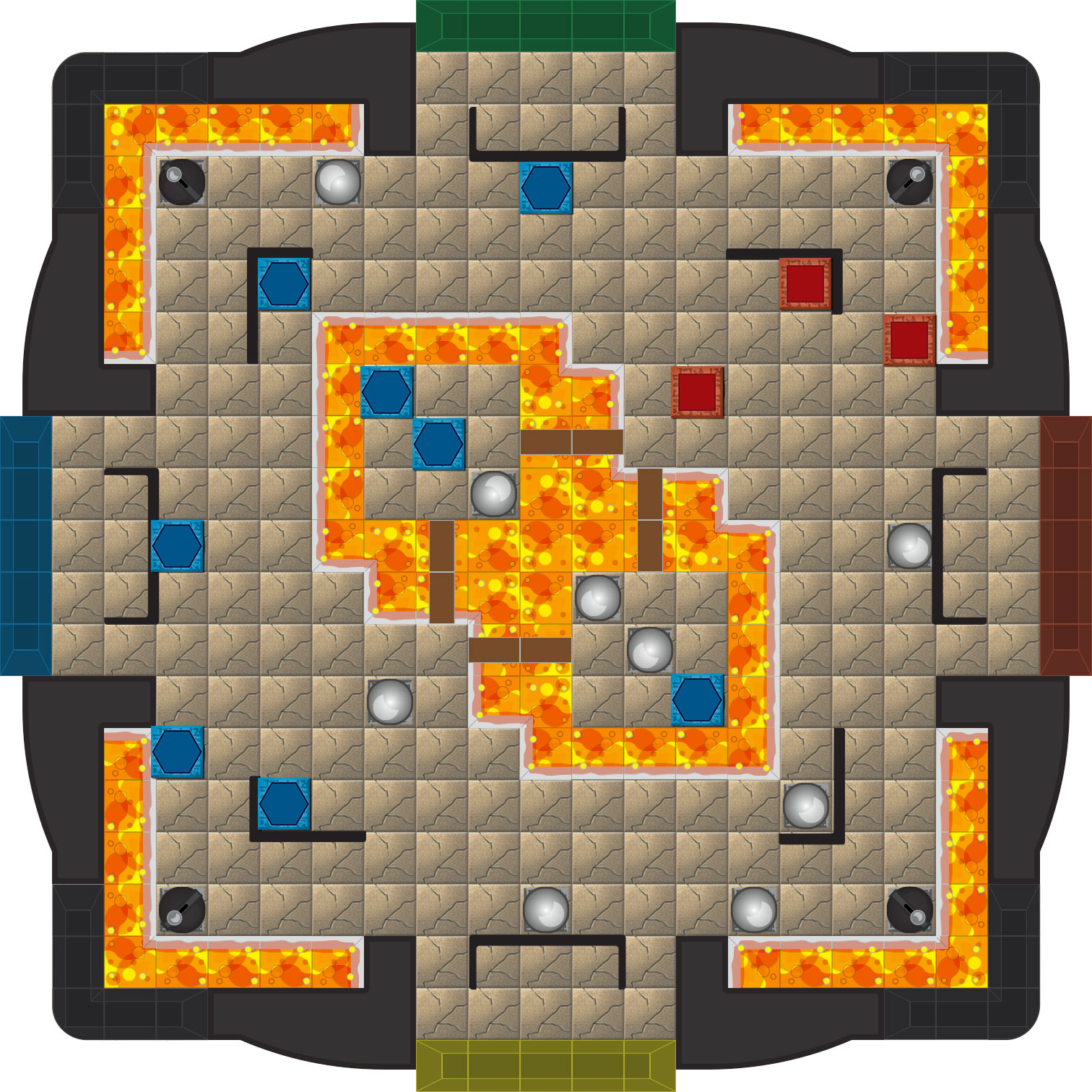
The red player has only 3 supply points and has 1 card in hand. At the start of their turn that player will draw 2 more cards to make a total of the default 3 card hand size.
The blue player has 7 regular control points, a center tower point, and 3 cards in hand. That player has 12 supply points so they will draw 2 more cards at the start of their turn for a total hand size of 5.
Power Cards
The power card deck consists of cards each with a number from 1 to 5. This number is the value of the card and can always be used to add to an attack value or a defense value. Some cards also have other abilities.
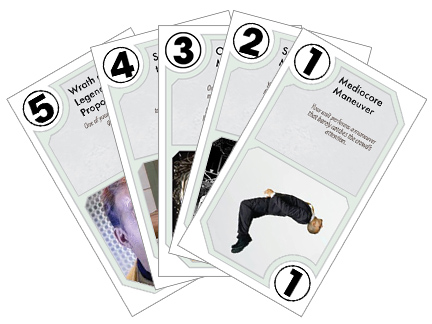
To use a power card, the player may either add the value to an attack or defense, or use the card’s other ability. A player must choose only one when using each card.
Some abilities can only be played on an active unit during its unit phase. If a power card does not require a unit phase or action phase, it must be played before or after a unit phase on that player’s turn.
After playing a power card, discard it faceup next to the power card deck. If the power card deck runs out of cards, shuffle the discard pile into a new deck to draw from.
Power cards that require an active unit must be played on that unit’s phase. Power cards can never be traded or discarded without being used. Power cards cannot be used to help other teams attack or defend.
Unit Phases
Each player gets two unit phases on their turn. A unit phase consists of a movement phase and an action phase for one unit. The movement phase and action phase can be made in any order.
Players may use their two unit phases on two separate units, or both unit phases on one unit. Each unit phase must be completed before moving on to the next unit phase. You may choose to have a unit skip its movement or action phase.
Cards that reference the active unit can only be used during that unit’s unit phase. Units that are incapacitated or in jail cannot use unit phases.
Movement Phases
During a movement phase, the unit may move a number of spaces equal to or less than its movement rating. Units may always move diagonally into valid spaces including next to walls and to and from bridges. A unit must end its movement phase to perform an action and movement points may not be split up before and after the action.
Units may not move through walls or onto lava. Units may not move through enemies. Units may move through their teammates. A tower can only be moved onto from an adjacent bridge space. Some items allow units to see through or walk over walls.
Action Phases
A unit may use an action phase to:
- capture a control point it is standing on
- activate a jail release point it is standing on
- attack an enemy unit within range and line of sight
- use an item or card that requires an action phase
(See Control Points and Jail Release on the board section)
Combat
Attacking
A unit may use an action phase to attack. To attack, declare one weapon that a unit is attacking with and declare the target. The target must be within range and in line of sight (see line of sight). The attacker may play any number of power cards from their hand and add the values together plus the strength of the weapon plus the unit’s strength. This number is the total attack value. A unit with no weapon can still attack with a strength 0, range 1, close combat punch attack.
Defending
The defending player may play any number of power cards from their hand. Add those power card values together plus the defending unit’s toughness, plus the toughness of all that unit’s equipped items. This is the total defense value.
Wounds
Subtract the total defense value from the total attack value to get the number of wounds added to the defending unit. All power cards used in the attack and defense are discarded. If at least one wound is added, the unit is considered to be wounded. Some items have additional effects if a unit is wounded, such as Push Back and Incapacitation, (see special abilities). The purple wound chips represent 3 wounds.
Wound chips are subtracted from the units starting vitae to show the current vitae of that unit. If a unit is reduced to 0 vitae that unit dies (see Death, Jails, and Beetle Shells)
Multiple Defenders
Some weapons or abilities (e.g. splash damage or hits all adjacent) affect multiple units in one attack. Power cards are only played once and the total attack value is applied to each defending unit. Likewise, cards played in defense against such an attack are applied to all defending units on that team. The defender always chooses the order of hits for their units. Players defend in the same order of play.
Weapons that allow additional attacks or additional attacks made with extra actions do not gain value from power cards played in previous attacks. New power cards may be played for each attack.
Range
All weapons and some items have a specific range of effect. To establish range, count the number of spaces from the unit to the target. If the target is within the specified range of the weapon or item, they are within range and if they are also in line of sight they can be attacked or targeted.
(see special abilities for more on ranged, targeting teammates)
Line of Sight
Line of sight determines what a unit can and cannot attack or target with a weapon or item. To target an enemy unit with an attack, that unit must be within range and in line of sight. If an item requires a unit to be adjacent to another unit to use its ability, that unit must also be within line of sight.
To establish line of sight, draw a straight line from any part of the attackers square to any part of the target square. If the line does not pass through a wall or the tower, that unit is in line of sight and may be targeted. If the line passes through a wall or the tower, that unit does not have line of sight and may not attack. Units themselves do not block line of sight.
Units on the ground level cannot see a unit on the center of a tower. They can only see units on the edge facing them. See the tower in the board section for details on the tower and line of sight.
Line of Sight Example
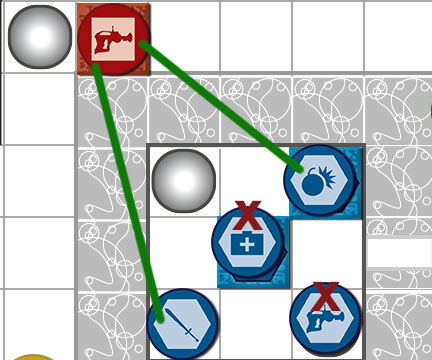
In this example the red gunner is looking to attack the blue team on the tower. The red gunner is holding the 44,000 magnum, so it can target up to 9 spaces away. The red gunner can only attack the warrior or the scout on the edges it can see.
Combat Example
The red warrior is attacking the blue gunner with a rusty chainsaw. The red warrior adds the warrior's strength of 2 plus the chainsaw’s strength of 1 for a sum of 3. The red team plays a 4 and a 3 power card adding 7 for the attack, for a total attack value of 10. The blue gunner is equipped with the cyber suit and the displacer helm, adding 4 toughness to its toughness of 1 for a total natural defense sum of 5. The blue team plays one 2 power card to add 2 making the total defense value 7. 10 attack value minus 7 defense value equals 3. So the blue warrior loses 3 vitae and takes 3 red wound chips.
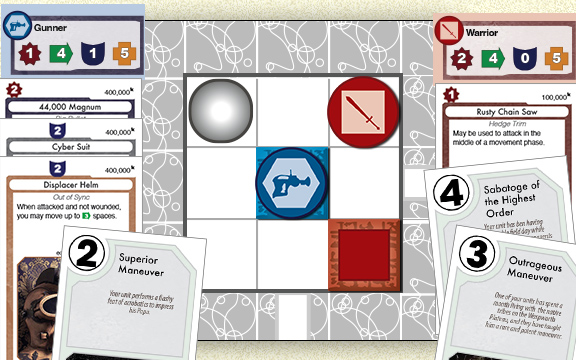
The Board
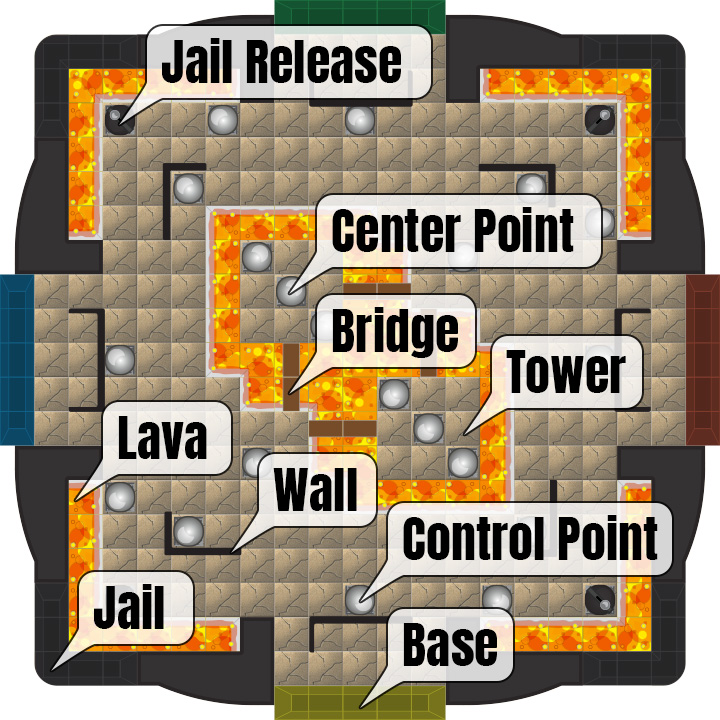
Bases
No units can be harmed inside their own base or attack from inside their base. Units cannot move or be pushed into an enemy base. No other actions may be used in the base. Only movement phases may be used in the base. Units may exit the base from any adjacent space to the base, i.e. units can be rearranged in the base without using movement.
Control Points
Units standing on a control point may use an action to capture that control point and flip it to their team color. Each control point in a team’s color is worth 1 supply point during the game and worth 100,000 credits at the end of the game. The center tower control point is worth 500,000 credits and 5 supply points. You may capture points from other teams, hand the supply marker back to that team, and replace it with your supply marker.
Lava
Units may not move onto lava spaces. Lava is at ground level and can be seen as normal from the ground. If a unit is pushed back onto a lava space they lose all vitae instantly and are sent to jail as normal.
Moving on Lava
If a card allows a unit to enter the lava they can enter and exit the lava from the floor or bridge as normal. They can also move off of the tower into the lava however they still must move onto the tower via a bridge space unless otherwise stated on a card.
Bridges
Units can walk on the bridges as normal. The bridges are at ground level and can be seen as normal from the ground. Diagonals are allowed onto and from the bridges. Bridges are the only way to access the tower unless otherwise stated on a card.
Towers
Each center control point on any tower is worth 500,000 credits and worth 5 supply points. The tower can only be accessed by the bridges and diagonals are allowed from the bridge to the tower.
Tower Line of Sight
Even when on the tower a unit cannot see over the walls on the ground.
No unit on the ground can see onto the center square of a tower and vice versa. Units can attack spaces that are on the edge of the tower using normal line of sight rules. A straight diagonal from the corner of a tower can see both full sides of the tower but never the middle of the tower or the other edges. The two towers are equal height and units on either tower can see all units on the other tower.
Higher and Lower Ground
Some cards add bonuses to a unit who is on higher ground. Higher ground indicates an attack from a unit on the tower to a unit not on the tower. The bridges and lava count as ground level for line of sight and higher ground rules.
Jails
Jails cannot be moved into. Units in jails cannot perform unit phases, actions or movement, and may not be targeted by items or abilities unless stated on the card.
Jail Release Points
Units standing on a jail release point may use an action to release all units in that jail returning them to their respective bases.
Special Abilities
Incapacitate
A unit wounded by a weapon with the Incapacitate ability is placed on its side. It is unable to move or perform an action on its teams next turn. At the end of its team’s next turn, it may be placed upright indicating that it is no longer incapacitated. An incapacitated unit may be the target of abilities but it may not become the active unit or be used in a unit phase.
Ignore Line of Sight
If a weapon indicates that it ignores line of sight attacks with this weapon are not stopped by walls or the tower. Targets still must be within the range for that weapon.
Push Back
To cause a Push Back effect, a unit must be wounded by an attack from a weapon with the Push Back ability. The wounded unit is pushed back 1 square. It is pushed back in a direct line from its attacker. If the wounded unit is up against a wall, or if there is another unit behind it, the push back effect is negated entirely. If the angle is not straight on the defending unit may choose which space to enter as long as it is moving away from the attacker. Units that are pushed into a lava space immediately lose all vitae.
Splash Damage
If a weapon indicates that it causes a Splash Damage effect, the targeted unit and all enemy units adjacent to the targeted unit are affected by the attack. Attacks must target a unit, splash effects cannot target empty spaces. Any Power cards used to enhance the attack also affect the adjacent units. Splash damage does not affect teammates. When a splash damage attack hits 2 or more of units all the cards played for defense are added to each unit’s toughness.
Hits All Adjacent
If a weapon indicates that it hits all adjacent enemy units, then all enemy units adjacent to the attacking unit are affected by the attack. Any Power cards used to enhance the attack affect all adjacent enemy units. When this attack hits 2 or more units all the cards played for defense are added to each unit’s toughness.
Payback
An item with payback will attack back when attacked. The payback attack happens after the initial attack is complete. The payback attack happens even if the unit with payback dies from the attack or is not in line of sight. Payback attacks are a set strength and do not get any weapon or unit strength added, power cards may be added to this attack.
Healing and Items That Target Teammates
Some medic items can be used on teammates to boost ratings or heal lost vitae. These items must target the unit carrying it or a teammate within range and line of sight of that unit. The [a] means this requires an action to use the effect. When a unit is healed remove wound chips from their card. Units may never have more vitae than their maximum starting vitae.
Close Combat vs Ranged
Close combat weapons can only target adjacent enemies. All weapon targets must be in line of sight to attack. Some armor adds additional protection against close combat or ranged weapons. These items look for weapon types and not range so a ranged weapon attacking an adjacent enemy is still a ranged attack.
Death, Jails, and Beetle Shells
When a unit has 0 or less vitae or touches lava (due to a push back), that unit dies. When a unit dies, the attacking player places that unit in a jail of their choice and then takes 1 beetle shell. Each beetle shell is worth 100,000 credits at the end of the game.
When a unit is placed in jail, remove all wound chips from it. Units in jail cannot take unit phases, action phases or movement phases, and may not be targeted by items or cards (unless otherwise noted on the card). The unit will remain imprisoned until it is released, see the jail release tile in the board section.
If a team is the only team left standing in the Death Dome, and all other team units are in jail, the match ends immediately and that team is automatically the match winner. Control point payout is still made based on the colors shown, so in this case it may be possible for the winner to not have the largest credit payout.
In a 3 or 4 player game, if one player has all of their units in jail, they may not take unit phases, but that player is still in the game. They can draw cards according to their current supply. That player will still get a payout at the end of the match based on control points of their color and beetle shells. There are some cards and items that can be used without unit phases (e.g. Jail Riot, or Vacuum Tube Escape).
Winning
The game is over at the end of the 6th round. At the end of the game each player takes their payout from the bank:
- 100,000 credits for each control point
- 500,000 credits for the center tower point
- 100,000 credits for each beetle shell
The winner is the team with the largest credit payout, or if all units except for one team are in jail, the game immediately ends and that team is the winner regardless of payouts.
Tie-Breakers
- If the top payout is tied, the winner is the team that controls the most center tower control points.
- If center points are tied the winner is the player with the most beetle shells earned in the match.
- If it’s still tied, the winner is the player with the least number of units in jail.
Enjoy the game!
Death Dome 3,000 Series
The following rules can be used to play a series of games for a league or extended play. This is the best way to experience the full magnitude of the Death Dome.
The series rules adds an auction phase to the game phases:
- Make purchases and equip team
- Play match
- Pay out winnings
- Auction Phase
(then repeat step 1 for the next match)
After a match each player collects their payout to determine the winner as normal. Then do the additional new Auction Phase (see below). Then clear all supply markers and wound chips and start the purchasing phase again for another match! The recommended series of play and simplest campaign play is a series of 5 matches, but you could continue on with a longer series.
Each player starts the series with 2 million credits.
Then play 5 matches:
- 6 round match
- 8 round match
- 10 round match
- 12 round match
- 12 round match
The player with the most valuable team at the end of the 5th match is the winner of the series!
Auction Phase
After each match take all units on the board that are not in jail and place them back in their bases. Take all units that ended the game in jail and place them on their team registry card.
The winning player may choose one unit who was in jail and force that player to sell back all items it was carrying. The selling player returns the items to the store and takes the total value in credits from the bank.
Then reshuffle the power deck, reset all control points and units. And begin the store phase for the next game. In the next match the winner will get to buy first and may purchase one of the items that was just sold back.
Team Value & Player Order
The winner of the last match gets to buy first in the purchase phase. After the purchase phase, figure out each team’s total value by adding all item costs and any left over credits. The highest valued team will get to be the first player for the match. The player with the least value should go last as this is an advantage in the final rounds.
If playing a 3 player game the higher valued team should also be the center base (set between the others as a further disadvantage). On the first match when all teams are even the player who is in the middle base should go last as an advantage to make up for having less open ground.
A team may keep credits on the side if they want to or can’t hold any more items. Those credits can be used later and count towards the overall team value.
A team may not keep items out of the game. All items must be equipped before ending the purchase phase as normal.
Card Notes
Items
Van Damme
If you have the Van Damme you can follow any unit, friendly or enemy that is adjacent to you. You may follow units that are pushed back or move because of another item. You may not follow units that move past you even if they stop during movement with a step-n-go, they must start adjacent to you. Unless otherwise noted adjacent always needs to be in line of sight.
Medical Pager
You may move right when wounds are added, if you make it to the wounded unit and they would be dead, you may still heal them! If the +2v brings them back to 1 or 2 vitae left you have saved them! The medical pager does not prevent the wound and will move after any Push Back or other wound effects occur. Units wounded from lava cannot be healed but the unit with this ability can still move toward them.
Power Cards
Action Movie Craze
Action Movie Craze may be played after all your actions are used to get one more action but it must still be played on the active unit only. This gives you an additional action phase only, not a movement phase or a new unit phase. If an additional attack is made with the new action then new power cards could be added to the attack.
Step-n-go
Step-n-go lets you attack or capture a control point mid-way through your movement, so you may continue using the rest of your movement after the action. You may decide how to use any remaining movement points after the results of any combat. This still counts as only one movement phase and does not count as starting a movement.
Killer Bee Hive and Mound of 1,000 Beetles
Killer Bee Hive and Mound of 1,000 beetles may be placed when you capture a point. You must capture a point to use it and you may not use it on the point you already control. Once the bug token is placed on the point it remains for the rest of the match. You are not hurt by the token when you place it. Any unit stepping ONTO that space will take the strength 10 attack. So if you move off and then back onto it you must defend against a strength 10 attack. No beetle shells are awarded for deaths from the bug tokens. Units pushed onto a token must defend against the attack. Units pushed back by a bug token are pushed back into the space they came from.
Hyper Cube
Hyper cube may be played any time on your turn. It sets the round counter back one round, so if it is the 4th round and you play hyper cube it becomes the 3rd round. The round counter continues to move up as normal at the start of the first player’s turn.
Pressured
Pressured may be used to boost a rating for your whole turn! This means movement boosts may be used by a unit for all movement phases in that turn. Or for strength for all attacks in that turn. Toughness boosts will lat until your next turn starts. Leave the pressured card out until the boost is gone to remind you that unit is pressured.
Characters
After you are familiar with the rules, you can add in the optional character deck and tokens.
Setup
Add the character deck in with the other store decks. This becomes another deck you can purchase from during the purchase phase.
Starting Teams
Separate and shuffle the 16 rank 0 characters, these are the starting characters. Deal out 4 starting characters randomly to each player. Set the other characters back in the store with the rest of the character deck. When playing with character cards you don’t need the team registry cards, your four character cards are your team.
After setting up the unit tokens, take the character token for each of your starting characters and place it on a unit token in your base.
Purchase Phase
You may purchase a character just like any other item. You must always have 4 character cards. If you want to buy a new character you must also sell a character in the same round and vice versa. Starting teams with characters will be worth 4,000,000 credits, though at least 2,000,000 credits will always be used for the 4 characters on your team.
During purchasing you may have some items you cannot equip if you do not have a character of a certain unit type. Before you can pass the purchasing phase to start the match you must have all items equipped. Unequipped items must be sold back to the store before the match begins.
Auction Phase
When the winner picks a unit to sell off in the auction phase that character card is also sold back to the store. If a player loses a character to the auction they immediately receive a new random rank 0 character. If there are no other rank 0 characters in the store that player gets the character back.
Character Cards
Unit Types
The type symbol at the bottom of the card shows what unit type each character is. This indicates which unit type deck they can equip.
Your team can consist of any arrangement of the 4 different unit types. For instance, your team might have two medics and two gunners, or it might have one scout, one medic, one gunner, and one warrior.
Units with 2 or more unit types can use items from any unit type deck it shares a type with. For example the Man Shaped Swarm could carry the Rusty Chainsaw or the Missile Launcher.
Unit Rank
The star rank insignia indicates the character’s rank and corresponds to their cost and ratings. Characters with no rank cost 500,000 credits and are the starting characters. Higher ranked characters can be purchased from the store.
Cost
The cost in credits to recruit the character for your team.
Abilities
Starting characters have no special abilities, but rank 1 or higher characters have abilities that give them special benefits in the match.
Style
Character style is to show some of the character’s personality and has no in-game effect.
Optional Scenarios
Holographic Johnny Cash Bonanza
Each time a player receives a beetle shell, that player draws 1 power card.
Bird Heardsworth’s Birthday
Each time a unit captures a control point that team draws 1 power card.
The Dual
For 2 players, use only the middle 3 board tiles, just 2 bases and the towers. Ignore the jail rules, each time a unit dies it immediately returns to their base.
Handicap
If starting a match with teams that differ by 500,000 credits or more. At the start of the match after each team draws 3 cards, the weaker team draws 1 extra card for each 500,000 credits in difference.
Bonus Matches
Play the normal match series but add 1,000,000 credits to each team’s winnings after each match.
Conglamagragon’s Return
Play the normal series but continue to play 12 round matches until a team is able to win a match with Conglamogragon on their team and not in jail at the end of the match.
Credits
Death Dome 3,000: Battle on the Waspworth Plateau
v2.05 © 2010 – 2021
Created by Ben B. and Kevan K.
Published by Opal Games
deathdome.com
Death Dome 3,000 Rules Reference
Get starting teamEach player picks a team registry, takes their supply markers and unit bases and 2,000,000 credits. Make PurchasesEach player may sell one item and buy one item per purchase turn. Each unit may equip up to 3 items. Each unit can only use up to 1 vehicle and 1 armor at a time. Pre-MatchBefore the first turn, set the round counter to 1 and each player draws 3 power cards. Your TurnAt the start of your turn draw up to 3 cards +1 card for every 5 supply points you have. Supply PointsA center tower control point is worth 5 supply points. All other control points are worth 1 supply point. Power CardsThe value of the card and can be used to add to an attack value or a defense value. You must choose to use the ability or the value in combat. Unit PhasesOn your turn you get 2 unit phases. A unit phase consists of 1 movement phase and 1 action phase for a unit. Movement PhasesMove a number of spaces equal to or less than a unit’s movement rating. Action PhasesA unit may use an action phase to:
|
Capturing Control PointsAny unit may use an action to place a supply marker on a control point that it is standing on. CombatUse an action to declare one weapon and a target within range and line of sight. Play power cards, then the defender plays power cards. The attack value is the total of any power cards played plus the strength of the weapon plus the unit’s strength. The defense value is the total of any power cards played plus the toughness of all items equipped plus the unit’s toughness. WoundsSubtract the total defense value from the total attack value to get the number of wounds subtracted from the defending unit’s vitae. Death, Jails, and Beetle ShellsWhen a unit has 0 or less vitae that unit dies. When a unit dies the attacking player places that unit in a jail and takes 1 beetle shell. Releasing JailsA unit standing on a jail release point may use an action phase to release all units from the jail returning them to their bases. Winning the Game & PayoutsA match lasts for 6 rounds. When all players have finished the final round the match is over. At the end of each match each team gets a credit payout. The player with the largest credit payout is the winner of the match!
|